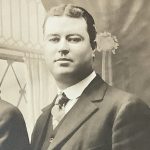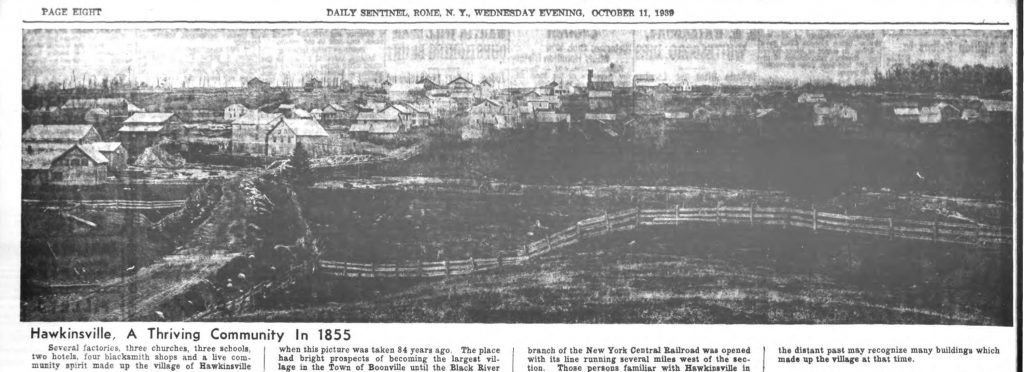Sepia Saturday 525. Third in a series about Albert Barney Charboneau — my paternal grandfather’s brother who died in the Great Influenza Pandemic of 1918.

Available documentation indicates that my dad’s Uncle Albert — who died in the 1918 influenza epidemic — spent his childhood and early teen years in Hawkinsville, Oneida Co., N.Y.
He was born there in 1885 and enumerated there in the 1900 U.S. census at age 15, as described in the last post.
Yet Albert’s adult years were spent in Dolgeville, Herkimer Co., N.Y., where he moved circa 1908 with his parents and three brothers — among them my paternal grandfather William Ray Charboneau — in the search of a better life.
A Black River Canal boom town
In the mid 1800s, Hawkinsville (shown below) was a small boom town located on the Black River Canal, which ferried Adirondack lumber, wood products and other goods to the Erie Canal and thence to markets throughout New York State and beyond.
My paternal French-Canadian great-great grandfather Laurent Charbonneau moved there in the 1850s, working first in the lumber industry and later as a farmer. His German-Swiss wife Ursula Zinsk, her parents and brothers also immigrated to the area, where the nearby mountains probably reminded them of home.

Hawkinsville’s sad decline
But by 1900 when their eldest grandson Albert appeared in his first census at age 15, Hawkinsville has fallen on hard times. An 11 Oct. 1939 article in the Rome, N.Y. Daily Sentinel titled “Bustling Village Fades To Hamlet With One Mill” summarizes the town’s decline.
A busy, thriving, industrial town, with prospects for a bright future was Hawkinsville, shown in the picture taken above about 1855, but the course of the Black River Railroad completely changed the picture.
Hawkinsville in the early days was larger than Boonville and had every prospect of growing steadily, until the railroad was built through Boonville, leaving Hawkinsville entirely off its course. Gradually the mills closed until the hamlet can now boast of but one mill.
The Dolgeville decision

Such an unfortunate demise for a village that once boasted three churches, two hotels, two saloons, a carpenter shop, four blacksmith shops, a wagon-shop, a cheese factory, a tannery, a millinery store — and so many mills that it was originally called Slab City for the slab wood turned out there, according to the same article.
Nevertheless, it may have been a sad family event that ultimately sealed the Charboneau family’s decision to leave Hawkinsville for good — the 1902 death of my great-great grandfather Laurent Charbonneau.
While Laurent was living, his home, land and farm may have anchored the family. But once the Charboneau family patriarch was gone, why not strike out for new opportunities? And those opportunities beckoned from the expanding Mohawk Valley town of Dolgeville in nearby Herkimer Co., N.Y.
There, German immigrant Alfred Dolge had set up a unique factory complex that drew thousands of workers from the U.S. and abroad — among them Uncle Albert, his parents and three brothers — and turned the sleepy town of Brockett’s Bridge into a bustling manufacturing center that was renamed Dolgeville in his honor.
More on this in the next post. Please stop back! Meanwhile, please visit the blogs of this week’s other Sepia Saturday participants here.
© 2020 Molly Charboneau. All rights reserved.
